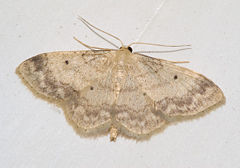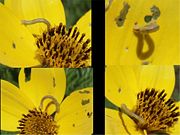Geometer moth
| Geometridae | ||||||||||||||||||||||
|---|---|---|---|---|---|---|---|---|---|---|---|---|---|---|---|---|---|---|---|---|---|---|
 Idaea deversaria (Sterrhinae: Sterrhini)
|
||||||||||||||||||||||
| Scientific classification | ||||||||||||||||||||||
|
||||||||||||||||||||||
| Diversity | ||||||||||||||||||||||
| About 2,000 genera > 26,000 species |
||||||||||||||||||||||
| Type species | ||||||||||||||||||||||
| Geometra papilionaria Linnaeus, 1758 |
||||||||||||||||||||||
| Subfamilies | ||||||||||||||||||||||
|
Alsophilinae (disputed) |
The geometer moths or Geometridae are a family of the order Lepidoptera. A very large family, it has around 26,000 species of moths described (over 300 of which occur in the British Isles). A well-known member is the Peppered Moth, Biston betularia, which has been subject of numerous studies in population genetics. Several other geometer moths are rather notorious pests.
Contents |
Adults
Many Geometrids have slender abdomens and broad wings which are usually held flat with the hindwings visible. As such they appear rather butterfly-like but in most respects they are typical moths: the majority fly at night, they possess a frenulum to link the wings and the antennae of the males are often feathered. They tend to blend in to the background, often with intricate, wavy patterns on their wings. In some species, females have reduced wings (e.g. winter moth and fall cankerworm).
Most are of moderate size, about 3 cm in wingspan, but a range of sizes occur. They have distinctive paired tympanal organs at the base of the abdomen (lacking in flightless females).
Caterpillars

The name "Geometridae" ultimately derives from geometer ("earth-measurer"). This refers to the means of locomotion of the larvae or caterpillars, which lack most of the prolegs of other Lepidopteran caterpillars. Equipped with appendages at both ends of the body, a caterpillar will clasp with its front legs and draw up the hind end, then clasp with the hind end (prolegs) and reach out for a new front attachment - creating the impression that it is measuring its journey. The caterpillars are accordingly called loopers, spanworms, or inchworms. They tend to be green, grey, or brownish and hide from predators by fading into the background or resembling twigs. Some have humps or filaments (see Filament-bearer image). They are seldom hairy or gregarious. Typically they eat leaves. However, some eat lichen, flowers or pollen. Some, such as the Hawaiian species of the genus Eupithecia, are even carnivorous.
Systematics
The placement of the example species follows a 1990 systematic; it may be outdated. Families are tentatively sorted in a phylogenetic sequence, from the most basal to the most advanced. Traditionally the Archiearinae were held to be the most ancient of the geometer moth lineages, as their caterpillars have well-developed prolegs. However, it nowadays seems that the Larentiinae are actually older, as indicated by their numerous plesiomorphies and DNA sequence data. They are either an extremely basal lineage of the Geometridae – together with the Sterrhinae –, or might even be considered a separate family of Geometroidea. As regards the Archiearinae, some species that were traditionally placed therein actually seem to belong to other subfamilies; altogether it seems that in a few cases, the prolegs which were originally lost in the ancestral geometer moths re-evolved as an atavism.[1].
Larentiinae - about 5,700 species, includes the pug moths, mostly temperate. Might be a distinct family[1].
Sterrhinae - about 2,800 species, mostly tropical
- Birch Mocha, Cyclophora albipunctata
- False Mocha, Cyclophora porata
- Maiden's Blush, Cyclophora punctaria
- Riband Wave, Idaea aversata
- Small Fan-footed Wave, Idaea biselata
- Single-dotted Wave, Idaea dimidiata
- Small Scallop, Idaea emarginata
- Idaea filicata
- Dwarf Cream Wave, Idaea fuscovenosa
- Rusty Wave, Idaea inquinata
- Purple-bordered Gold, Idaea muricata
- Bright Wave, Idaea ochrata
- Least Carpet, Idaea rusticata
- Small Dusty Wave, Idaea seriata
- Vestal, Rhodometra sacraria
- Common Pink-barred, Rhodostrophia vibicaria
- Middle Lace Border, Scopula decorata
- Cream Wave, Scopula floslactata
- Small Blood-vein, Scopula imitaria
- Lewes Wave, Scopula immorata
- Lesser Cream Wave, Scopula immutata
- Mullein Wave, Scopula marginepunctata
- Zachera Moth, Semiothisa zachera
- Blood-vein, Timandra comae
- Eastern Blood-vein, Timandra griseata
Desmobathrinae - pantropical
Geometrinae - emerald moths, about 2,300 named species, most tropical
Archiearinae - 12 species; Holarctic, southern Andes and Tasmania, though the latter some seem to belong to the Ennominae[1]. Larvae have all the prolegs except most are reduced.
- The Infant, Archiearis infans (Möschler, 1862)
- Scarce Infant, Leucobrephos brephoides (Walker, 1857)
Oenochrominae - in some treatments used as a "wastebin taxon" for genera that are difficult to place in other groups.
Alsophilinae - a few genera, defoliators of trees. Might belong in the Ennominae, tribe Boarmiini[1].
- March Moth, Alsophila aescularia
- Fall Cankerworm, Alsophila pometaria
Ennominae - about 9,700 species, including some defoliating pests; global distribution.
Geometridae genera incertae sedis include:
- Dichromodes
- Nearcha
See also
- List of geometrid genera
Footnotes
References
- Hausmann, A. (2001): The geometrid moths of Europe. Apollo Books.
- Minet, J. & Scoble, M.J. (1999): The Drepanoid / Geometroid Assemblage. In: Kristensen, N.P. (ed.): Handbuch der Zoologie. Eine Naturgeschichte der Stämme des Tierreiches / Handbook of Zoology. A Natural History of the phyla of the Animal Kingdom (Vol. 4: Arthropoda: Insecta. Part 35: Lepidoptera, Moths and Butterflies vol. 1: Evolution, Systematics, and Biogeography): Chapter 17. Walter de Gruyter, Berlin & New York.
- Scoble, M.J. (ed.) (1999): Geometrid Moths of the World: A Catalogue. CSIRO Publishing. ISBN 0-643-06304-8
- Young, Catherine J. (2008): Characterisation of the Australian Nacophorini using adult morphology, and phylogeny of the Geometridae based on morphological characters. Zootaxa 1736: 1-141. PDF abstract and excerpt
External links
- Anacamptodes pergracilis, cypress looper on the UF / IFAS Featured Creatures Web site
|
|||||||||||||||||||||||||||||||